By Deborah Arriaga Weiss & Guadalupe Quintana Pali
Introduction
In Oaxaca there is a strange riddle that is quite difficult to solve – when talking about mezcal (also written “mescal”) – that is, never drink less than two or more than three”. Normally, when trying to solve this riddle, the curious end up asking themselves: “So, what’s the moral of the story?”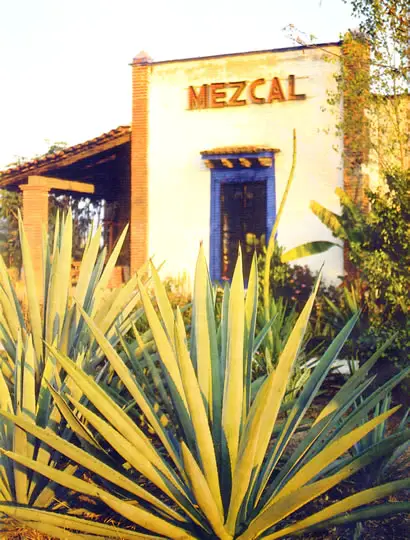
| Mezcal and Tequila are the best known Mexican liquors |
The gods of the pre-Hispanic world gave men and women of this Earth countless gifts; among these, the agave, of which they learned to use every part. That’s why the Spanish, surprised by its multiple uses, called it the tree of wonders and compared it to the Antilles agave, calling it maguey.
In the modern-day state of Oaxaca. an alcoholic beverage called mezcal is wade from the maguey that grows there, just as the blue agave from Jalisco produces Tequila, the one found in Chihuahua is used to make sotol and the cactus from Sonora produces bacanora and pulque from the highland variety. The principal is the same but each distills a unique flavor based on the local maguey species, the climate and the secrets of each distillation process. Thus, it is said that each drink has its own maguey and each maguey its own region.
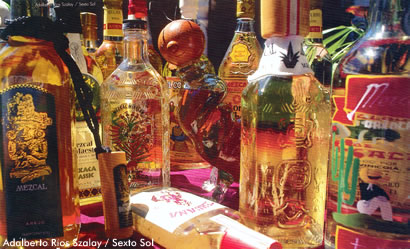 |
| Mezcal bottles |
Mezcal is the final result of distilling the trunk –or -piña” (pineapple)– of the agave mezcalero that was first cooked in an earthen oven lined with stone. That’s why mezcal has a smokey earthy flavor with its own rich body, aroma and 40º GL.
 |
| Oaxaca and its location in Mexico |
From a ritualistic regional tradition, the custom of drinking mezcal has spread. The social context of its consumption has also changed, going from bars to international markets where it has won popularity. Mezcal now has its official Mexican standard and appellation, and is considered another of Mexico’s contributions to the world.
Both men and women drink mezcal in ceremonies and social activities: in baptisms, weddings and funerals; to bless the cornfield both during planting and harvest; when falling in love or falling out of love. They drink to find courage or to swallow betrayal. They toast to good health and have a sip when they’re feeling sick. Mezcal is drunk in sorrow and in joy, in poverty and in wealth, in heaven or when in “hell”.
That is why the old adage synthesizes all its qualities and contradictions: for each misfortune: mescal; for all good fortunes: pour me another one!
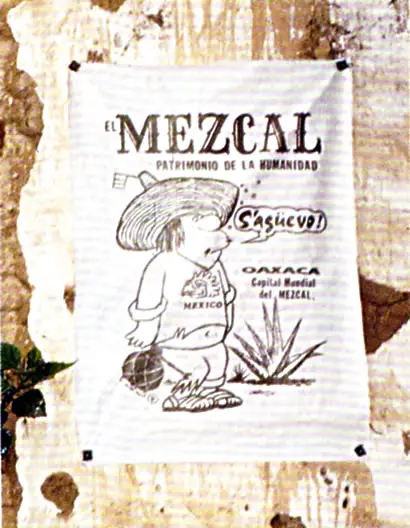 |
| Mezcal Patrimonio de la humanidad |
The Legend
The legend tells us that there once was a cold and sober, and very generous goddess.
 |
| Mezcal worms |
Her body was like the trunk of the agave, but instead of leaves she had 40,000 breasts. From her breasts flowed the elixir drunk by those that venerated her; she was Mayatl, Zapotec goddess of mescal.
Cold and untouchable, she first came in touch with her feelings when some worms burrowed into her heart and were trapped forever. Thus she learnt of arousal, desire and finally love. She soon fell in love with a brave, handsome, although somewhat timid warrior named Chag.
Chag didn’t feel worthy of her favors, in desperation, the goddess offered him the most beautiful and luxuriant of her breasts for him to drink the elixir that poured from her heart.
 |
| Mayatl |
He drank, and drank, until, in drunken dispair, the warrior said: “make me a god or become a woman”… unfortunately, for the romantically inclined, the legend ends at this point. However, the moral is clear, isn’t it?
It is important to point out that prehispanic mezcal was different from the drink produced after the arrival of the Spaniards, which is now so famous.
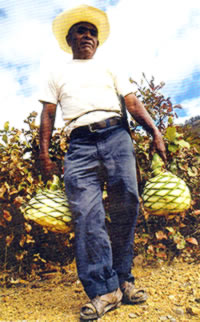 |
| Agave piñas off to the palenque |
The distilling process was unknown in precolumbian times. Drunkenness was punished by death, so alcoholic beverages were very low grade and used exclusively for religious ceremonies.
Alcohol was produced by simple plant juice fermentation, especially the maguey.
Prehispanic mezcal was simply fermented maguey juice or tepache made from the cooked heart of the plant, a process natives learned, supposedly, if we are to believe the legend, when lightning struck an agave and burned the piña, a dark liquid poured from the plant, mezcal.
Spaniards added stills to the process (an Arab invention) and started to produce high alcoholic level beverages. So today’s mezcal is a mestizo, a hybrid of both local and European ideas, as is Mexico itself.
Modern Mezcal Production
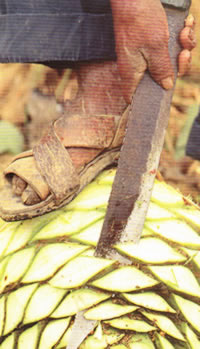 |
| Agave “jima”, when the leaves are cut off during harvest |
There is a long journey between planting the maguey and a shot of mezcal. It goes through a series of steps combining ancient techniques with modern industrial processes, distilling and bottling.
The most common variety of mezcal-producing maguey is the espadin (Agave angustifolia haw), followed by the arroqueño (Agave esperrima jacobi) and the tobalá (Agave potatorum succ), which grows in the wild. Maguey plants take anywhere from 7 to 9 years to mature, no matter the variety.
Endless rows of agave plants cover the landscape of the Central Valleys and Southern Sierra of Oaxaca, as is the case in the countryside of some regions of Guerrero, Durango, San Lois Potosi and Zacatecas.
In general, this is mountainous terrain, making mechanized farming virtually impossible. The plant grows in the wild without using chemical products.
 |
| Agave fields |
Mayatl’s breasts no longer supply the world with mezcal: it is the modern farmer’s skilled hands that tend the plant. They also hand-harvest the mature trunk or piña and and carry it to its final destination: the palenque or mezcal factory.
A traditional palenque is comprised of three areas: the cooking area, where the piña is baked in a circular earthen oven lined with stone; crushing, where juices are extracted by grinding the piña in an old-fashion mill and grindstone; and the area where the juices are fermented, distilled and bottled.
 |
| Agave is crushed in a mill |
Modern distilling is mostly in wooden tubs and copper stills, but in very traditional or household palenques, earthenware pots and reed pipes are used. This is the minimum necessary infrastructure required to obtain authentic mezcal, to preserve its agave spirit and capture its essence of smoke and earth.
For the liquor’s final presentation, distilleries have let their imagination take flight. Mezcal bottles have become a true art form and collectors avidly seek the rarest blends bottled in hand-blown glass.
Mezcal Types
 |
| Mezcal with a maguey worm |
– “Mezcal with the worm”, in which a red maguey worm (Hypopta agavis) is added in the bottling process.
– “Mezcal de pechuga” is distilled along with a chicken breast.
– “Tobalá mezcal”, manufactured from the heart of the tobalá maguey that grows in the wild and is only distilled in earthenware pots.
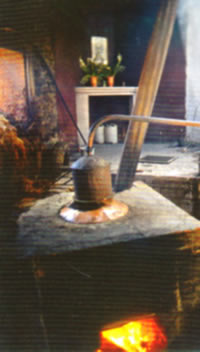 |
| Mezcal still |
– The one with a sad name, “Miner’s mezcal”: the purest form of the liquor, the product of the first distillation, paid in decades past as part of a miner’s salary so the effects of the alcohol would mitigate the exhaustion of the back-breaking labor.
– Other mezcales sport the names of herbs, flowers or fruit, depending on which ingredient was added during distillation process: pennyroyal, mint, peach and so on.
– There are also a variety of Mezcal liqueurs are also manufactured with mezcal, sugar syrup, honey and/or fruit.
– Finally, as with it’s brother Tequila, there’s also aged mezcal (reposado), depending on the time it has been is left to mature within wooden barrels.
Mezcal today
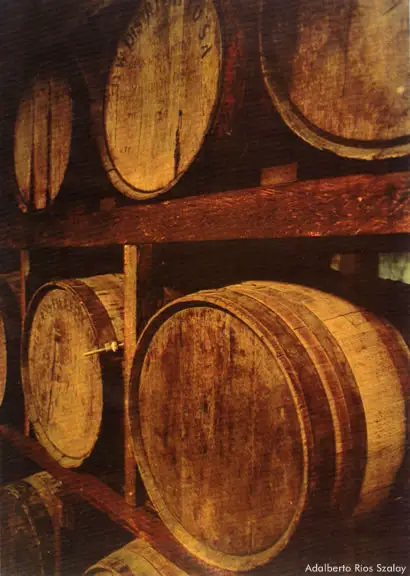 |
| Mezcal reposado – aged in wood barrels |
Mezcal is a handcrafted beverage: its production and marketing both a family and community tradition, its consumption is basically a social activity.
Along with pulque and tequila, mezcal is part of Mexico’s popular trilogy of drinks derived from the maguey plant. This is strange when you consider that the three were regional beverages whose production, distribution and consumption were seriously restricted for more than 200 years.
Perhaps its ritualistic use, especially in the case of mezcal, consolidated its popularity. Mezcal is used to bless the planting of crops, new arrivals in the family, a new community house (even a new life in the great beyond) a few drops are sprinkled on the grave to send the soul on its way. It is an essential companion for community work projects and on the patron saints’ days, when it is served according to the local hierarchy and to refuse a cup would be tantamount to sacrilege.
 |
| Mezcal Hacienda in Mexico |
Mezcal can be imbibed on any occasion. It doesn’t require refrigeration or ice. Normally, it isn’t mixed, but occasionally can be used in cocktails.
Best of all, though, is to drink it in short, slow sips. There are those who like to suck a lemon and taste a bit of maguey worm salt (ground up and mixed with chili pepper) after each drink.
Mezcal is strong and hits hard; overdoing it will put you in a state of permanent stupor. We recommend you stop before reaching this state, when you can still remedy the situation or as popular sayings go, remember your goddaughter’s name, take another waltz around on the floor, light a candle for the dead, or find a happy ending to the story.
But, as composer Chucho Palacios sings on his song “Copitas de mezcal”:
“Pour us another little glass of mezcal, nothing is gained from weeping anyway…!”


Leave A Comment